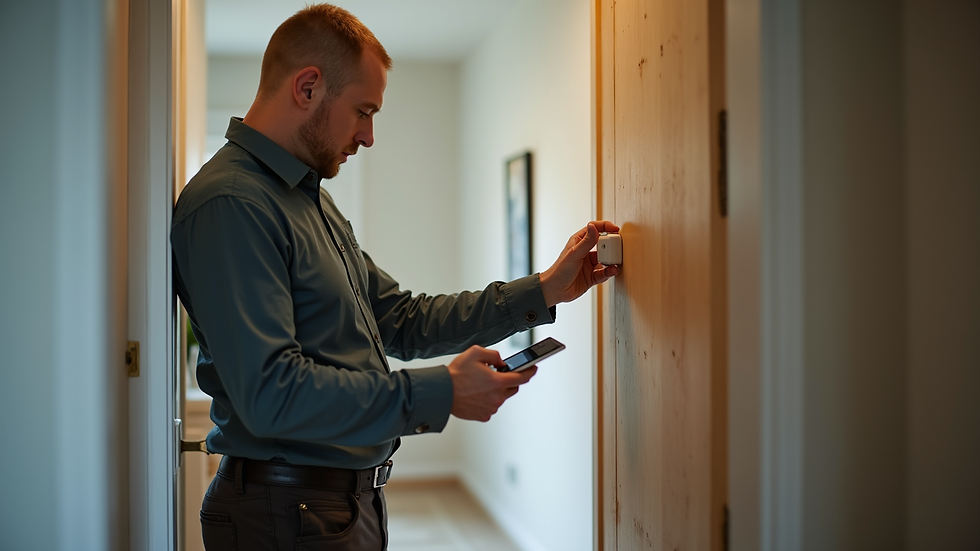Protect Your Home: Radon Testing Services Explained
- Frank Talarico
- Sep 16
- 4 min read
Radon is a silent threat that can affect any home, regardless of age or location. This naturally occurring radioactive gas is colorless, odorless, and tasteless, making it impossible to detect without proper testing. Exposure to high levels of radon over time can lead to serious health risks, including lung cancer. Understanding the importance of professional radon inspection is crucial for anyone involved in real estate transactions or simply wanting to ensure their home is safe.
Why Professional Radon Inspection Matters for Your Home
Radon gas originates from the natural breakdown of uranium in soil, rock, and water. It can seep into homes through cracks in foundations, gaps around pipes, and other openings. Because radon is invisible and undetectable by human senses, the only way to know if your home has elevated radon levels is through testing conducted by trained professionals.
A professional radon inspection provides:
Accurate measurement of radon levels using specialized equipment.
Identification of radon entry points in your home.
Recommendations for mitigation if radon levels exceed safety limits.
Documentation that is often required during real estate transactions.
For buyers and sellers, a professional radon inspection can be a critical part of the home evaluation process. It ensures that the property is safe and can help avoid costly surprises after the sale.

Understanding the Process of a Professional Radon Inspection
A professional radon inspection typically involves several key steps to ensure reliable results:
Initial Assessment
The inspector evaluates the home’s structure, foundation, and potential radon entry points. This helps determine the best locations for placing radon detectors.
Placement of Radon Detectors
Devices are placed in the lowest livable areas of the home, such as basements or ground floors. These detectors remain in place for a specified period, usually 48 hours to 7 days, depending on the testing method.
Data Collection and Analysis
After the testing period, the devices are collected, and the data is analyzed to determine radon levels. Professional inspectors use calibrated equipment to ensure accuracy.
Reporting
A detailed report is provided, outlining the radon levels found, potential risks, and recommendations for mitigation if necessary.
Mitigation Recommendations
If radon levels exceed the EPA action level of 4 picocuries per liter (pCi/L), the inspector will suggest effective mitigation strategies to reduce radon concentrations.
Using professional radon testing services ensures that the testing is done correctly and the results are trustworthy. This is especially important during real estate transactions where accurate information is essential.

How Radon Testing Services Protect Your Investment
Radon testing is not just about health; it also protects your financial investment. Here’s how:
Avoiding Future Costs: Homes with high radon levels may require expensive mitigation systems. Early detection allows buyers and sellers to negotiate repairs or price adjustments.
Ensuring Compliance: Many states and municipalities require radon testing during real estate transactions. Meeting these requirements avoids legal complications.
Increasing Marketability: A home with a recent professional radon inspection report can be more attractive to buyers, providing peace of mind.
Protecting Occupants: Long-term exposure to radon is the second leading cause of lung cancer. Testing ensures the safety of everyone living in the home.
For homeowners, regular radon testing is a proactive step to maintain a healthy living environment. For buyers and sellers, it is a critical part of due diligence.

Practical Tips for Homeowners and Buyers
If you are considering radon testing or have just received your results, here are some practical recommendations:
Test Every Home: Regardless of location, radon can be present anywhere. Testing is the only way to know.
Use Certified Professionals: Always hire certified radon inspectors to ensure accurate testing and reliable results.
Test During Real Estate Transactions: Include radon testing as part of the home inspection process when buying or selling.
Follow Up on High Levels: If radon levels are above 4 pCi/L, invest in a mitigation system. These systems are effective and can reduce radon levels by up to 99%.
Retest After Mitigation: Confirm that the mitigation system is working properly by conducting follow-up tests.
Consider Water Testing: Radon can also be present in well water. Testing water sources is important if your home uses a private well.
Taking these steps helps ensure your home remains a safe place for you and your family.
Taking Action: How to Get Started with Radon Testing
Getting started with radon testing is simple and straightforward. Here’s how to proceed:
Contact a Professional
Reach out to a certified radon testing company. For reliable and thorough inspections, consider radon testing services.
Schedule an Inspection
Arrange a convenient time for the inspector to visit your home and set up the testing equipment.
Prepare Your Home
Keep windows and doors closed during the testing period to ensure accurate results.
Review the Report
Once testing is complete, review the detailed report with your inspector. Ask questions and understand the findings.
Plan Mitigation if Needed
If high radon levels are detected, work with professionals to install a mitigation system promptly.
By following these steps, you can protect your home and investment from the dangers of radon exposure.
Radon is a hidden hazard that requires attention and action. Professional radon inspection and testing provide the knowledge and tools needed to safeguard your home. Whether you are buying, selling, or simply maintaining your property, understanding radon and taking the necessary steps to test and mitigate it is essential for health and peace of mind.



Comments